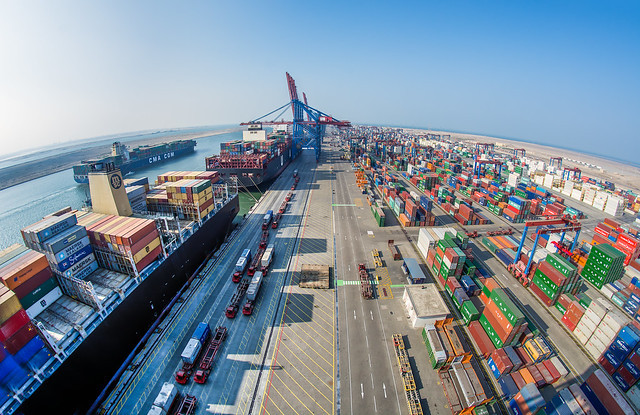
Suez Canal Container Terminal (SCCT) Photo: APM Terminals
Verifiable costs for transiting the African Cape rather than the Suez Canal are around US$1,000 per box according to Xeneta chief analyst Peter Sand, who was responding to questions on how western bombing had changed the maritime supply chain seascape.
Speaking after coalition forces bombed targets in Yemen in an effort to neutralise the threat to merchant shipping in the Red Sea, Gulf of Aden and Gulf of Oman, US has effectively escalated the regional war, admitted Sand.
“Tensions were already high now they are a bit higher,” he told Container News. He said container shipping would not return in any numbers to the Suez Canal until they are convinced that it is safe.
That means if disruptions last for longer than three months carriers are likely to add ships to loops and rework services to meet the new reality, less than three months of disruption will see services head for the cape, but will be cut short at either end.
With rates edging up to around US$5,300-5,500/TEU this week, Sand believes that the disruption to supply chains will have a disproportionate effect on smaller shippers who are less able to rapidly react to the chaotic nature of the Far East to Europe trades, than the more resourced shippers and forwarders.
In a ‘back of the envelope’ calculation of the extra verifiable costs of transiting the Cape, Sand said that while there would be savings in insurance and Suez Canal costs of around US$1.5 million a ship, the extra fuel for the longer journey, 20 days on a round trip, will add US$1.2 million. With charter rates at US$60,000/day that would add a further US$1.2 million and other expenses will see verifiable costs increase to US$2.5 million per ship, per round trip, translating to around US$1,000/container, Sand said.
Global Shippers’ Forum (GSF) director James Hookham believes there should only be a month of schedule disruption, but as services are developed and ships added to loops the timings should settle down to a comparatively normal system, albeit with longer transit times.
“Overnight action [by coalition forces] have effectively declared the whole region a war zone for the foreseeable future,” claimed Hookham, adding that, “shippers should prepare for extra costs.”
However, the disruption should not be on the scale of the pandemic. “There will be a period of realignment, but assuming there is no wider escalation there should be a one-off hit to scheduling,” said Hookham.
As a result, rates should settle and because we are aware of the limits of this disruption it should be possible to see the boundaries of the disruptive nature of the Middle East conflict.
According to the GSF, many shippers see the end of Chinese New Year, which starts on 10 February and ends on 17 February, as the start of the contract renewal season.
Hookham urges shippers to see through the “fog of war” and “even though the military situation may become worse, ships are safe going around the cape.”
Mary Ann Evans
Correspondent at Large
Sources: Container News
 Hotline: 0944 284 082
Hotline: 0944 284 082
 Email:
Email: 


 VN
VN